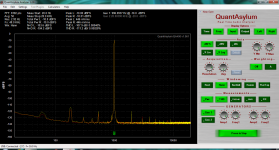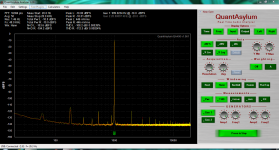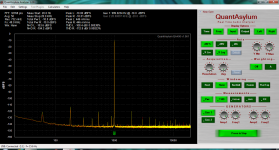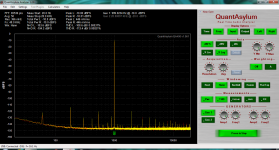Unfortunately Ethernet would require almost a junior computer to run the device. There are several standards for audio over ethernet, they either are more like a streaming protocol for internet music or are almost completely incompatible with a normal network. And then getting the software to talk to the audio device appearing in a strange place. Not impossible but a lot more software to deal with. SPDIF really does work and really doesn't have jitter problems when implemented correctly.
A Juli card as an interface into a PC is the simplest and cheapest way to get a stable connection for SPDIF I have found. Making a replacement for the existing analog card could be a good option, not easy but probably easier than the other options here. I would support such an effort.
USB is not synchronous. Firewire was, but it is gone. It is my understanding in real studios they use Ethernet and run a separate master clock. Way out of the DIY range.
I have a question about the QA400's channel matching:
Can anyone tell me if it's normal to have several dB discrepancy between the Left and Right channel THD readings in loopback mode?
See pics attached - notice the discrepancy grows as the FFT length is increased.
Can anyone tell me if it's normal to have several dB discrepancy between the Left and Right channel THD readings in loopback mode?
See pics attached - notice the discrepancy grows as the FFT length is increased.
Attachments
as setting the level lower than 0dB in the continuous run oscillator dialog box did not produce a signal that the VP-7725 was able to read.
An externally hosted image should be here but it was not working when we last tested it.
An externally hosted image should be here but it was not working when we last tested it.
You need to go to the calibration menu to get a continuous tone. The system is designed to work in bursts.
Thanks Demian.
I measured the output with a high bandwidth true-RMS'r -- which lead me to put the QA400 on my HP3577A. Here's a 1kHz tone, from 100Hz to 1MHz:
I measured the output with a high bandwidth true-RMS'r -- which lead me to put the QA400 on my HP3577A. Here's a 1kHz tone, from 100Hz to 1MHz:
An externally hosted image should be here but it was not working when we last tested it.
Here's a 1kHz tone, from 100Hz to 1MHz:
You will be more surprised, if you enlarge 😀 the bandwidth to 100 Mhz 😱
Hp
You will be more surprised, if you enlarge 😀 the bandwidth to 100 Mhz 😱
Hp
What's going on up there?
There is some noise up around 100MHZ, but it's about 50dBm down from the noise at 100kHz. I ran a sanity check to make sure it wasn't something in the ULF ham band, a.m broadcast band, computer monitor etc. Maybe it's that communications system with the Chinese submarine fleet.
It's there all the time, whether the device is running continuous tone or not. When I unplug the QA400 from the 3577a and insert an 50 ohm attenuator input it goes to -120dBm.
My AP is in for service, so I used the AA5001 to measure the continuous tone THD+N% of the QA400. Without the "Audio Band" filter it was not very good.
I would change out the BNC connectors for insulated variety so they aren't part of the chassis, use an isolated USB adapter with a separate wall wart power supply (not the USB power), put some ERS paper inside top and bottom over the digital circuitry and allow for a knurled banana jack so the chasis could be grounded. Just my 2 pfennigs.
An externally hosted image should be here but it was not working when we last tested it.
I would change out the BNC connectors for insulated variety so they aren't part of the chassis, use an isolated USB adapter with a separate wall wart power supply (not the USB power), put some ERS paper inside top and bottom over the digital circuitry and allow for a knurled banana jack so the chasis could be grounded. Just my 2 pfennigs.
does it need to be knurled? 😉
à chacun son goût. Personally, I like mine knurled.
Without the "Audio Band" filter it was not very good.
Using a filter the measurement is for my understanding useless 🙄
The measurement will also whole environment, dependent of RF sources and sinks 😀
Hp
@kevinkr -- i put a ferrite clamp on the USB cable and the noise is still there.
@HpW -- i think that there's a wide-spread perception that nothing happens above 20kHz, you may not be able to hear a pure tone above 20kHz, but you can recognize the artifacts of noisy switchers, etc ... the THD+N measured on the AA5001 is 0.633% with no low pass filters switched in.
@HpW -- i think that there's a wide-spread perception that nothing happens above 20kHz, you may not be able to hear a pure tone above 20kHz, but you can recognize the artifacts of noisy switchers, etc ... the THD+N measured on the AA5001 is 0.633% with no low pass filters switched in.
In the closed system of the QA400 it doesn't see the out of band stuff. However it does see the ground currents etc. The reason for the interface I'm working on is to deal with the noise currents. I went over some of this at the beginning of the thread.
I am still working on gen 2 that addresses some dynamic range issues to better match to how this is used.
Meanwhile, try a cliplead from the PC to the chassis of the box you are testing. Give the ground noise currents a separate path.
Sent from my Nexus 7 using Tapatalk
I am still working on gen 2 that addresses some dynamic range issues to better match to how this is used.
Meanwhile, try a cliplead from the PC to the chassis of the box you are testing. Give the ground noise currents a separate path.
Sent from my Nexus 7 using Tapatalk
It's there all the time, whether the device is running continuous tone or not. When I unplug the QA400 from the 3577a and insert an 50 ohm attenuator input it goes to -120dBm.
I get same thing with my QA400 and using my Anritsu network/spectrum analyzer .... peak energy centered at 100KHz.
Thx-RNMarsh
- Home
- Design & Build
- Equipment & Tools
- QuantAsylum QA400 and QA401



